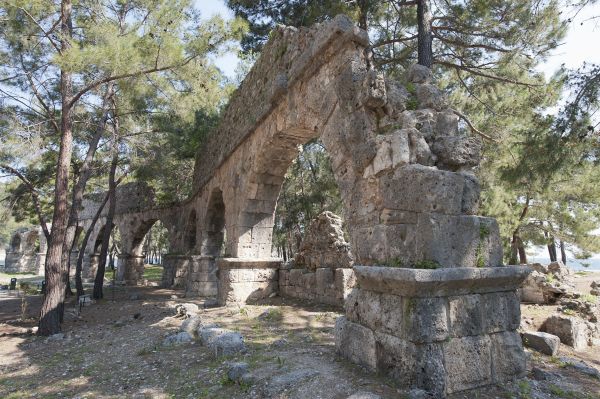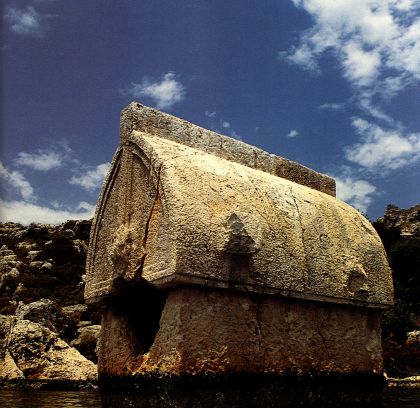Buy or gift a stand-alone digital subscription and get unlimited access to dozens of back issues for just £18.99 / $18.99 a year.
Please register at www.exacteditions.com/digital/cornucopia with your subscriber account number or contact subscriptions@cornucopia.net
Buy a digital subscription Go to the Digital Edition
Aqueduct arches at Phaselis, beneath the seaside pines (Dick Osseman)
The Lycian city of Phaselis, west of Antalya is magically situated beside pines right by the sea and one of the most picturesque in the country. Founded by the Rhodians around 600 BC on an isthmus between two harbours, it was a major port in classical times. It was here that Alexander the Great spent the winter of 334/333BC, and the Romans sourced their attar of roses (still produced inland in Isparta). But it subsequently fell victim to pirate attacks and lost its importance. The ruins stand in pine woods that climb the rocky escarpments of the Taurus Mountains, and have been jealously guarded by Turkish law since the birth of the Republic. ‘Who can weave, to repeat it, the spell of Phaselis in her solitude at dawn?’ wrote Freya Stark in The Lycian Shore. In 2014 it had a narrow escape when was a local ruling halted construction on a 288-room hotel slated to be built right by this idyllic site, which was reported on the Cornucopia blog, Phaselis: another paradise lost. But the danger might not be over yet.
After years of walking through some of the most important countryside along the Turkish Mediterranean, a lone English woman has documented a networkof ancient roads and mountain paths that once linked the cities of ancient Lycia.
Kate Clow abandoned her life as a London computer consultant, and is now helping to foment a rural revolution in Turkey, indirectly challenging the army, the government and even the bank that awarded her top prize in a prestigious environmental contest.
Clow has painstakingly mapped a 250km route from Fethiye, the ancient Telmessos, to the city of Antalya, where she herself now lives. It follows the ancient, cobbled roads, goat trails and paths that are used by nomadic herdsmen. It also covers more than a millennium of human history, passing graves dating from 700BC and unexcavated Byzantine monasteries from 800AD. To walk the whole route at a single stretch takes just under six weeks.
The most westerly part of Turkey’s southern coast is backed by towering mountains that tumble headlong right to the shore of the beckoning Mediterranean.
It is one of the most dramatic of coastlines, alternating between sandy beaches and hostile cliffs that have long been the terror of sailors. Inland, two fertile valleys that have traditionally supported their inhabitants are honeycombed with the ruins of a unique civilisation.
No traveller can escape the spell woven by the constellations of tombs which look down upon the land from cliffs and hilltops. Little is known of the culture of the ancient Lycians, the architects of these temples, tombs and sarcophagi, but there are a few encouraging facts to help the visitor. Isolated by their dramatic landscape (the coast road only completed its tortuous route some thirty years ago), the Lycians lived as a peaceful confederacy of city states, governed by the deliberations of a proportionally representative body, a feat the civilised Greeks never managed.
The heartland of the Lycian state was the Xanthos River, now known as the Esen Çayı. The land is still meticulously worked; we saw many a group of women bent double in the small patchwork of cotton fields, their white headscarves matching the unpicked buds. The occasional man would carry a full bag to the side, returning with empty sacks for refilling. Dusk was rush hour as rosy-cheeked pickers returned home on the backs of tractors and trailers.
We followed one such party up the steep, rutted road to the ruins of ancient Tlos, one of the five major cities of the Lycian confederacy, which stands back from the river, surveying its progress from on high. The view, in all its hazy greens and blues, entranced us into spending the night among the crumbling walls of an Ottoman fort in which the traveller and antiquarian Sir Charles Fellows, in the 19th century, described taking tea with the Bey. Below us the perpendicular façades of the rocks were punctuated by tombs, ranging from simple rectangles of stone panelled to look like heavy wooden doors to Ionic temples, complete with columns, capitals and entblature…


 Issue 66, December 2023
Turkey’s Centenary Issue
Issue 66, December 2023
Turkey’s Centenary Issue

Cornucopia works in partnership with the digital publishing platform Exact Editions to offer individual and institutional subscribers unlimited access to a searchable archive of fascinating back issues and every newly published issue. The digital edition of Cornucopia is available cross-platform on web, iOS and Android and offers a comprehensive search function, allowing the title’s cultural content to be delved into at the touch of a button.
Digital Subscription: £18.99 / $18.99 (1 year)
Subscribe now